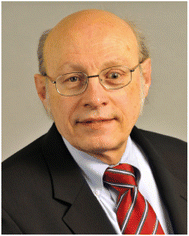Molecular Analysis for Art, Archaeometry and Conservation
Francesca Casadio * and Richard P. Van Duyne *
 Francesca Casadio | Dr Francesca Casadio joined the Art Institute of Chicago in 2003 to establish and direct a state-of-the-art conservation science laboratory. As the Museum's first A.W. Mellon Senior Conservation Scientist she is in charge of planning and carrying out scientific research in support of the preservation and study of the Museum's collection. Dr Casadio has also established and co-directs the Northwestern University/Art Institute of Chicago Center for Scientific Studies in the Arts. She received her Ph.D. and M.S. degrees in Chemistry from the University of Milan, Italy. |
 Richard P. Van Duyne | Professor Richard P. Van Duyne is the Charles E. and Emma H. Morrison Professor of Chemistry and of Biomedical Engineering at Northwestern University. He received a B.S. (1967) at Rensselaer Polytechnic Institute and a Ph.D. (1971) at the University of North Carolina, Chapel Hill, both in Chemistry. He is a member of the National Academy of Sciences and the American Academy of Arts and Sciences. He is known for the discovery of surface-enhanced Raman spectroscopy (SERS), the invention of nanosphere lithography (NSL), and the development of ultrasensitive nanosensors based on localized surface plasmon resonance (LSPR) spectroscopy. |
It is a pleasure to present this web-themed issue of Analyst and Analytical Methods centered on ‘Molecular Analysis for Art, Archaeometry and Conservation’. The appearance of this themed issue is timely, attesting to the development and high degree of sophistication of a strongly interdisciplinary field that in the last decade has grown exponentially in ambition and reach, as testified by the recent establishment in 2012 of a new Gordon Research Conference on Scientific Methods in Cultural Heritage Research.
To meet the global challenge of preserving our rich cultural heritage and advancing our knowledge of it, researchers have harnessed the potential of science and technology to bring new research and discoveries to the arts. This web-themed issue showcases such exciting new research and will have particular relevance for those interested in the study and preservation of great art of the past and present, but it also highlights how most of the analytical breakthroughs described here have great technology-transfer potential to fields that range from semiconductors to security. Challenges to current analytical methods and the need to develop new ones are posed by the requirements of irreplaceable, severely size-limited and hierarchically-complex samples, as well as by a desire to perform highly detailed and sensitive mapping of molecular information at multiple length- and time-scales on the surface as well as in the bulk of objects of cultural significance. The fact that this web-themed issue spans the scope of both journals is a testimony to the ability of the field to push the envelope of the analytical sciences as well as to its characteristic of applying established analytical techniques to address research questions in art, archaeometry and conservation that have high societal impact. The deeply emotional and edifying power of these contributions is confirmed by the many times in which the articles gathered for this web-themed issue have made it to the cover of their respective journals.
This themed issue highlights the myriad of disciplines required and the techniques employed to study art and cultural objects at the level necessary to characterize their structure, properties and chemistry. It comprises a broad collection of papers by researchers representing chemistry, physics, materials science, archaeology and conservation from academia, national laboratories and museums showing how the material complexity and age of artworks lead to challenging research questions.
Contributions focus on a wide diversity of target analytes, with a high number of papers focused on the analysis of paintings, pigments, dyes, inks and their degradation products. Ricciardi et al. (DOI: 10.1039/c3ay40530c) combine Fibre Optic Reflectance Spectroscopy (FORS) and X-ray fluorescence analysis to chart the use of green pigments and mixtures in manuscript illuminations drawn from over 50 examples in the collection of the Fitzwilliam Museum in Cambridge, UK, comparing material evidence with contemporary historical treatises spanning the 13th to the 16th century. Robinet et al. (DOI: 10.1039/c3ay40906f) provide an in-depth investigation of the blue pigment smalt and its alteration in 16th to 18th century paintings. With a leap forward in time, Cesaratto et al. use time-resolved photoluminescence to shed light on 19th/20th century cadmium-based pigments (DOI: 10.1039/c3ay41585f), whereas Strlič et al. literally go beneath and beyond the paint to non-invasively explore the canvases of famed Spanish surrealist artist Salvador Dali (1904–1989) (DOI: 10.1039/c3ay41094c), as well as systematically studying the composition of historically informed iron-gall inks (DOI: 10.1039/c3an00331k).
In-depth studies of glass and ceramic materials are also represented in the work of Medeghini et al. (DOI: 10.1039/c3ay41304g) who use a multi-analytical approach to shed light on the probable place of manufacture of archaeological pottery from an Early Bronze Age site in Jordan, and by Colomban et al. (DOI: 10.1039/c3ay40648b) who discuss the analysis of ancient enameled glass masterpieces.
Many advances in our knowledge of organic materials are discussed. Kirby et al. (DOI: 10.1039/c3an00925d) present the innovative method of peptide mass fingerprinting (PMF) for the identification of collagen materials in a museum setting with high sensitivity and specificity to a family level and sometimes even to a species level. Several other contributions focus on collagen-based materials such as the famous Dead Sea Scrolls as described by Mašić et al. (DOI: 10.1039/c3an00609c), and Rabin and Hahn (DOI: 10.1039/c3ay41076e) who cover all aspects from characterization to provenancing and degradation. The complex composition and multifaceted alteration of Asian lacquer is described in detail by Le Hô et al. (DOI: 10.1039/c3an00608e), whereas Daher and Bellot-Gurlet (DOI: 10.1039/c3ay41278d) propose the use of vibrational spectroscopy to monitor and characterize the surface alteration of hard fossilized resins. Even exoteric materials such as blood encrustations are unraveled with direct analysis in real time mass spectrometry (DART-TOF-MS) by Fraser et al., during the investigation of a mysterious flaking coating on an African mask in the collection of the Detroit Institute of Arts (DOI: 10.1039/c3an00633f).
Finally, a significant group of papers describes the results of pushing analytical methods to new limits for what concerns both minimally invasive and totally non-invasive techniques. In the first category, Surface Enhanced Raman Spectroscopy (SERS) and synchrotron methods of analysis dominate, with many valuable contributions. The papers by Shah et al. (DOI: 10.1039/c3an00788j), Wustholz et al. (DOI: 10.1039/c3an00611e), Pozzi et al. (DOI: 10.1039/c3ay40673c), and del Puerto et al. (DOI: 10.1039/c3an00446e) all report on innovative SERS approaches for the identification of minute quantities of organic pigments and dyes in paint, watercolors, textile fibers and even colored feathers; while Mazzeo et al. (DOI: 10.1039/c3an00057e) describe an immunoassay for the detection of ovalbumin in paintings based on SERRS probes composed of gold nanoparticles functionalized with Nile Blue. The high number of papers in this area firmly establishes SERS as an emerging and powerful new technique for the ultrasensitive molecular analysis of art and archaeology.
Synchrotron sources coupled to conventional sources are used for the highly-sensitive detection of the photoluminescence properties of zinc oxide pigments with the aim of discriminating materials of different provenance (Bertrand et al.; DOI: 10.1039/c3an36874b). In addition, they are used by Mass et al. for the investigation of ultra-thin altered layers of cadmium sulfide yellow paints in Henri Matisse's (1869–1954) iconic painting Le Bonheur de vivre (1905–6), at the Barnes Foundation (DOI: 10.1039/c3an00892d). For what concerns completely non-invasive mapping and imaging, near infrared spectroscopy is discussed in two very different applications. Kennedy et al. demonstrate its use in assessing multi-phase earth-built heritage buildings (DOI: 10.1039/c3ay40735g), whereas Delaney et al. (DOI: 10.1039/c3an00926b) are able to map the distribution of organic binders in Early Renaissance paintings using near infrared reflectance imaging spectroscopy, something that was thought to be unattainable until a few years ago.
The breadth and scope of molecular analysis in art, archaeology and conservation is brilliantly exemplified in this issue, and we are grateful to the Editors at the Royal Society of Chemistry for charging us with the opportunity to showcase such excellent research, as well as to this themed issue's authors for entrusting their papers to us. Because of the possibilities opened by online publishing, we know and hope that new contributions will continue to augment this initial set of papers, establishing a useful and stimulating reference set for other researchers as well as new generations of scientists who are interested in this field of research.
A deep connection to our past and shared cultural heritage must be preserved to foster a balanced society where all humanity can thrive. Scientific research on objects of cultural heritage allows new behind-the-scenes glimpses beneath the surface of famous works of art and cultural relics, reveals unexpected facets of an artist's mind and creative journey, and bolsters our ability to care for our common heritage. The contributions of the analytical sciences to this deeper understanding of our cultural patrimony cannot be underestimated and it is our great pleasure to be able to celebrate them with the outstanding contributions to this special, web-themed issue.
Francesca Casadio (The Art Institute of Chicago) and Richard P. Van Duyne (Northwestern University, USA)
| This journal is © The Royal Society of Chemistry 2013 |
